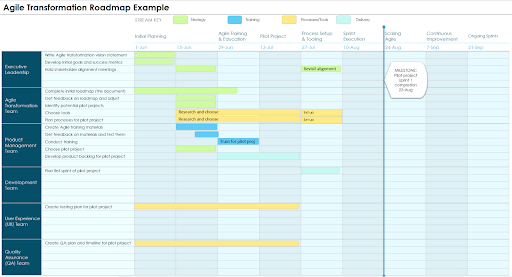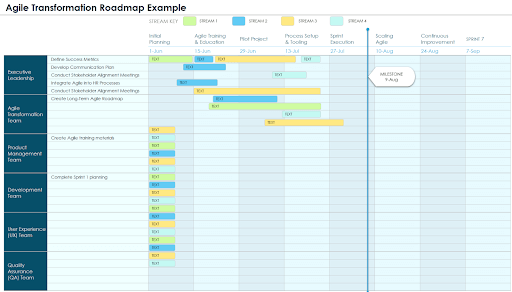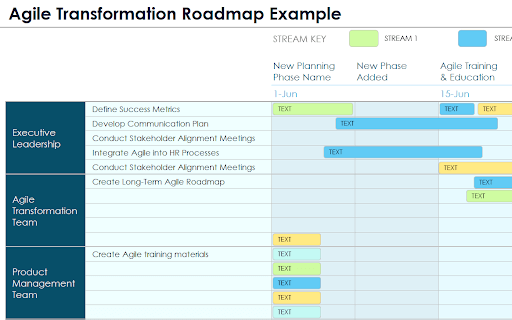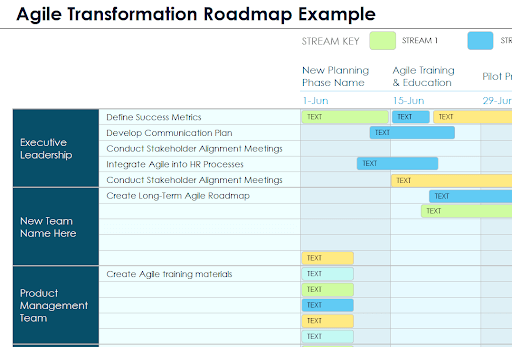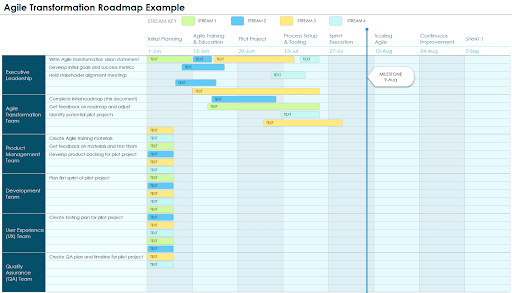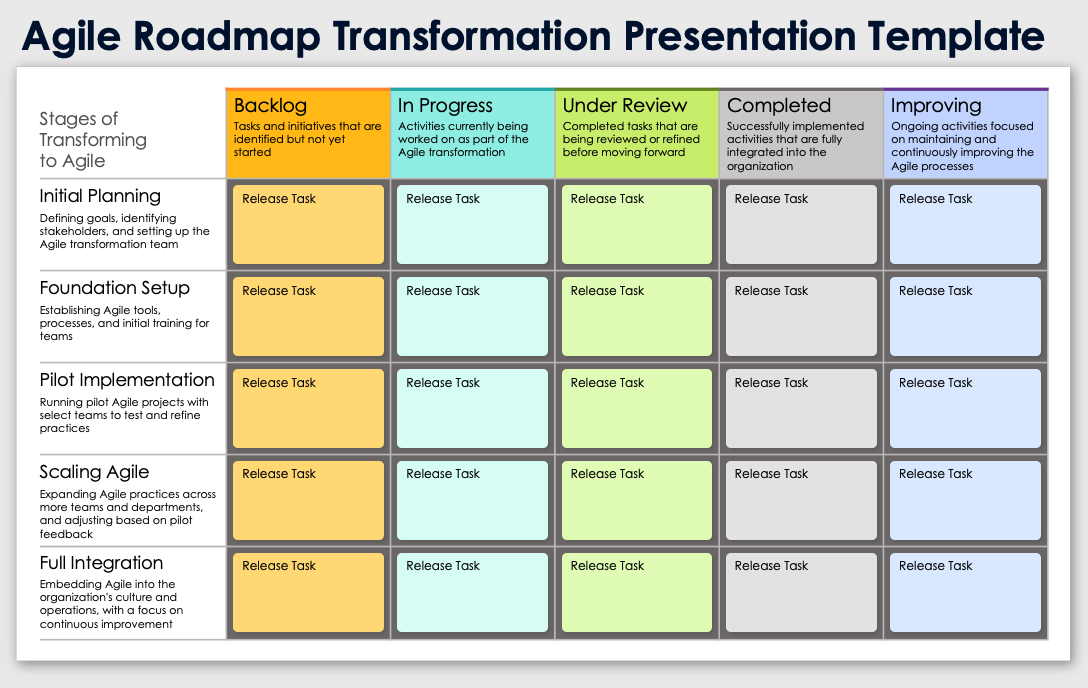What Is Agile Transformation?
Agile transformation is the process of spreading Agile work principles throughout an organization. It typically involves implementing Agile methods and enabling flexibility among teams. Agile transformation takes hold in phases and requires processes and people to adapt to new situations.
Top-Down vs. Bottom-Up Agile Transformation
Senior managers lead top-down Agile transformation as they set strategic direction. Conversely, teams drive bottom-up Agile transformation, focusing on grassroots adoption and iteration. Organizations can combine the two approaches for effective, sustainable change.

Michael Schmied, Co-founder and Lead Financial Consultant of Kredite Schweiz, a Swiss loan provider, says he has worked on Agile transformations in the financial sector that benefited from a mix of the two approaches.
“I think you need that top-down approach to get people aligned quickly, but for anything sustainable, you need the teams involved from the bottom up, too,” he says. “Otherwise, it just won’t stick.”
What Is an Agile Transformation Roadmap?
An Agile transformation roadmap is a strategic concept and a living document. The concept refers to the entire approach to becoming Agile. The document outlines key tasks, goals, and milestones within a flexible framework that supports feedback and continuous improvement.
Typically, the main roadmap document includes phases such as planning, training, the pilot project, the process setup, scaling, and more. Each phase lists tasks and objectives for specific teams. Creating and adjusting an Agile transformation roadmap requires input from multiple levels of the organization on strategic goals and team-level practices. A well-crafted roadmap keeps the transformation on track.

Reade Taylor, CEO of Cyber Command, a cybersecurity solutions company, advises clients to maintain straightforward roadmaps that are easy to follow. “Keep roadmaps simple, focused on priorities, not details,” he advises. “Revisit frequently. Share the ‘why’ behind each step so everyone understands the vision.”
An Agile transformation roadmap must be flexible enough to adapt to changing circumstances. Since Agile principles emphasize responsiveness to change, the roadmap should allow for iteration and continuous learning. The roadmap should be a living document that evolves as Agile project management takes hold.
“Things are going to change whether you plan for it or not,” Schmied says. “You need to leave room for those unexpected roadblocks. I’ve seen teams get stuck when they don’t adapt fast enough.”
Learn more about managing projects using Agile with this complete resource for implementing Agile project management, and examine the Agile principles further in this comprehensive guide to the Agile Manifesto
.
Main Elements in Agile Transformation Roadmaps
An Agile transformation roadmap includes key elements for organizing and visualizing essential tasks, including phases, timelines, tasks, teams, and milestones. The tasks include creating supporting documents such as a goals statement, a baseline assessment, an Agile training plan, and more.
Here are descriptions of an Agile transformation roadmap’s main elements, which are also shown in the example above:
- Phases: The phases represent the different stages of the Agile transformation journey. Typical phases include planning, pilot implementation, process setup, sprint execution, scaling, and continuous improvement. Each phase should have clearly defined objectives and deliverables. For example, the planning phase may involve assessing your current state and creating a vision and goals statement, while the scaling phase focuses on expanding Agile practices across more teams. Phases divide the transformation into manageable chunks, ensuring steady progress.
- Timeline: The timeline outlines when you’ll execute each phase and its associated tasks. It helps the organization stay on track and meet key deadlines. A well-structured timeline includes short- and long-term milestones, with the flexibility to adjust as the transformation evolves. For instance, a pilot project will have a specific timeframe, followed by assessment and scaling plans. The timeline ensures that the Agile transformation progresses in a timely manner while allowing room for iteration.
- Tasks: Tasks are the actionable steps required to execute each phase of the roadmap. Examples of tasks include forming Agile teams, conducting training, implementing pilot projects, and assessing outcomes. You should list the tasks and assign them to specific individuals or teams for accountability. A clear list of tasks ensures that nothing is overlooked during the transformation, and it provides a practical guide for moving from one phase to the next.
Read this best practices guide to Agile project planning and learn how to stay on track with your goals.
- Stakeholders/Teams: Agile transformation involves multiple stakeholders at various levels of the organization. This includes senior leadership, team managers, Agile coaches, and individual team members. Defining roles and responsibilities for each group is essential for success. Stakeholders may be responsible for strategic decisions, while teams handle the day-to-day Agile practices.
- Streams: Streams represent thematic, concurrent tasks in the Agile transformation. Each stream may tackle specific initiatives, such as technology upgrades, team restructuring, or process refinement. This approach ensures that multiple initiatives progress in parallel, enabling a holistic transformation.
- Milestones: Milestones are key achievements that indicate progress throughout the Agile transformation. Successfully completing the pilot project, scaling Agile practices to additional teams, or achieving certain performance metrics such as faster time-to-market or improved team collaboration are all examples of milestones. Milestones serve as checkpoints to celebrate progress and reassess the strategy if needed. They also provide visibility to stakeholders, showing tangible results at various stages of the transformation.
- Supporting Documents: Supporting project management documents provide the necessary framework and guidelines to back up the transformation. Supporting documents serve as reference points, ensuring consistency in the transformation process and providing clarity on objectives and expectations for everyone involved. Examples may include:
- A goals statement that outlines the vision for Agile adoption
- An Agile training plan for employees
- A pilot project charter that details the scope and objectives of initial Agile implementations
Together, these elements create a comprehensive roadmap that ensures an organized, well-communicated, and successful Agile transformation.
How to Build an Agile Transformation Roadmap
Creating an Agile transformation roadmap is easier if you start with a template, which provides a framework to build on. You can customize it for your organization and show your teams, tasks, and timeline.
Here are the detailed steps to build an Agile transformation roadmap:
- Download a Roadmap Template
Instead of building a roadmap from scratch, download a template. Here’s a free Agile transformation roadmap template in Excel. These steps will show it in use.
- Customize Phases Across the Top
Modify the template to reflect your specific transformation phases (e.g., planning, pilot, scaling). This template follows usual Excel functionality. To change a phase name, click in the cell and type a new name. To add more phases — or two-week sprints within a phase — click on an existing column and add a column to the right or left. The example below shows “New Planning Phase Name” typed into the template’s first phase and “New Phase Added” in a new second column.
When adding customized phases, it’s useful to leave room for regular check-ins or review sessions to ensure that there is room for flexibility in the roadmap. Mary Zhang, Head of Marketing and Finance at Dgtl Infra, recently helped to build an Agile transformation roadmap at her company. She says that her roadmap “included quarterly review sessions where we assessed our progress, gathered feedback from various levels of the organization, and made necessary adjustments to our plan. This flexibility proved invaluable as it allowed us to respond to unforeseen challenges and capitalize on unexpected opportunities.”
- Customize Teams on the Left Side
Type over the example teams to list your teams or departments along the left side. These serve as swimlanes to show who does what. The screen below shows “New Team Name Here” added under the first block of rows.
- List Major Tasks for Each Team
For each phase, outline major tasks that the corresponding teams will undertake. Examples include “Conduct Agile Training” or “Launch Pilot Sprint.” The prefilled tasks offer a few examples of what you might include. The screen below shows how to begin filling out tasks for each team.
- Get Feedback from Stakeholders
Share the initial roadmap draft with key stakeholders for feedback. This collaborative process will help refine the tasks, adding or removing items to better align with the project goals. - Sequence the Tasks by Phase
Sequence your tasks logically in the left column. Then begin copying and pasting the colored rounded boxes into their appropriate phases. Delete the extras. In the example below, you now see tasks arranged by phase and sprints in a Gantt chart. In addition, you see them colored by streams, described in the next step.
- Option: Group Concurrent Tasks into Streams
By marking some tasks as streams, you can show how different teams will contribute concurrently to a thematic set of tasks. Example streams are training, processes, tools, customer feedback, tracking, and delivery. To simplify, eliminate the streams and just show tasks by team and timeline. - Include Milestones and Key Deliverables
Identify significant milestones, such as completing pilot projects or expanding Agile to multiple teams. These checkpoints will help measure progress. In the example above, we marked the completion of the first pilot project sprint (“Sprint Execution”) as a milestone. To add milestones, copy and paste the existing one. - Link and Organize Supporting Documents
Add links to any supporting documents, such as training plans, goal statements, and project charters. Ensure all documents are stored in an accessible, organized folder for easy reference. - Regularly Review and Update the Roadmap
Agile is iterative, and your roadmap should be as well. “Don’t be afraid to revisit the roadmap often. It’s not set in stone,” Schmied says. Regularly revisiting the roadmap allows you to adjust based on progress, feedback, or new information. This ensures the roadmap stays relevant and achievable.
Agile Transformation Roadmap Templates
Use these Agile transformation templates to guide your journey holistically and piece by piece. They include an overall Agile transformation roadmap template, along with templates for individual projects within it.
Basic Agile Transformation Roadmap Template
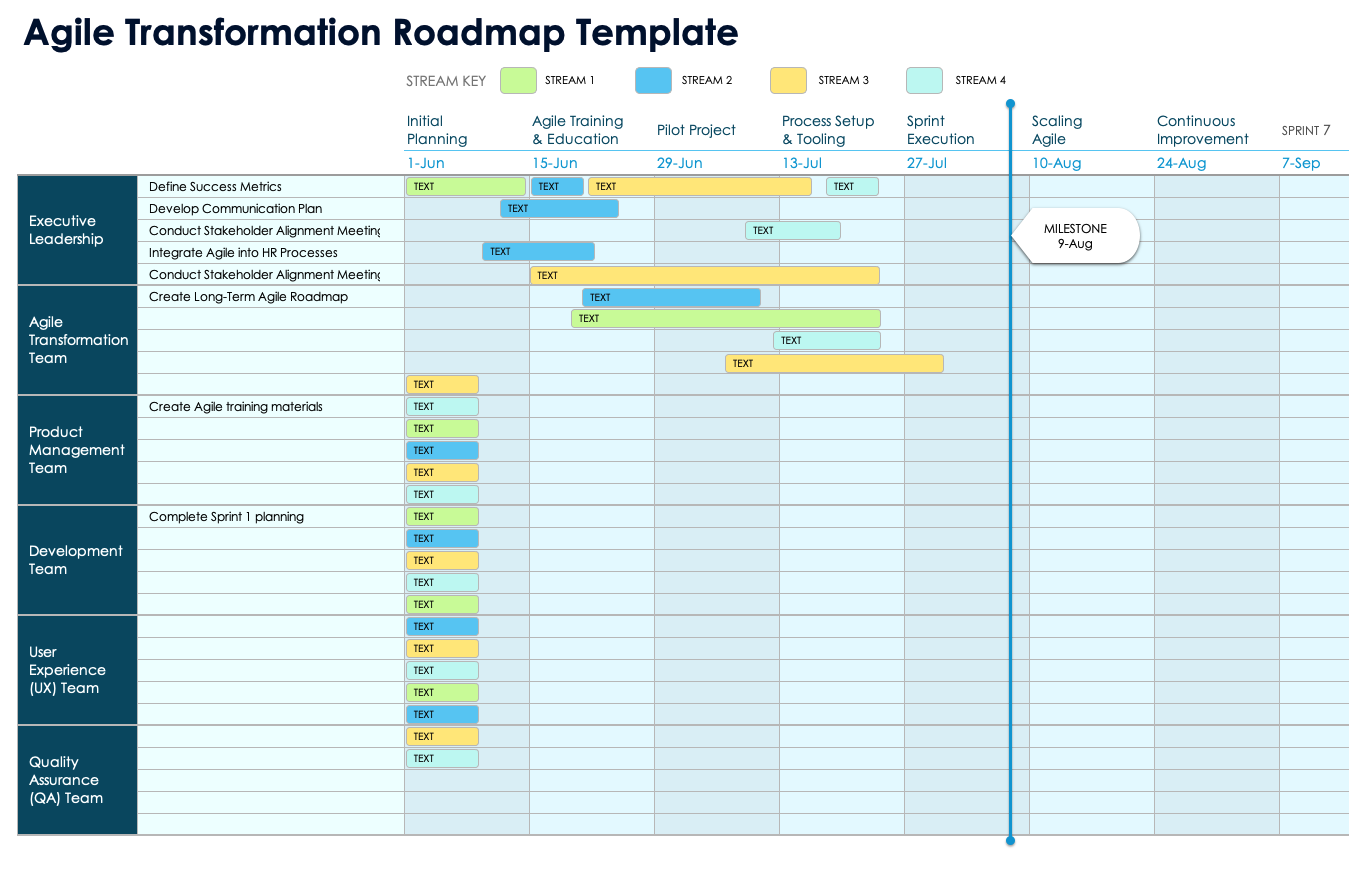
Download an Agile Transformation Roadmap Template for
Excel | PowerPoint | Google Sheets | Google Slides
Use this overall Agile transformation roadmap template to plan your implementation holistically. It includes tasks grouped by swimlanes for each team, plus timelines and milestones.
Agile Pilot Implementation Roadmap Template
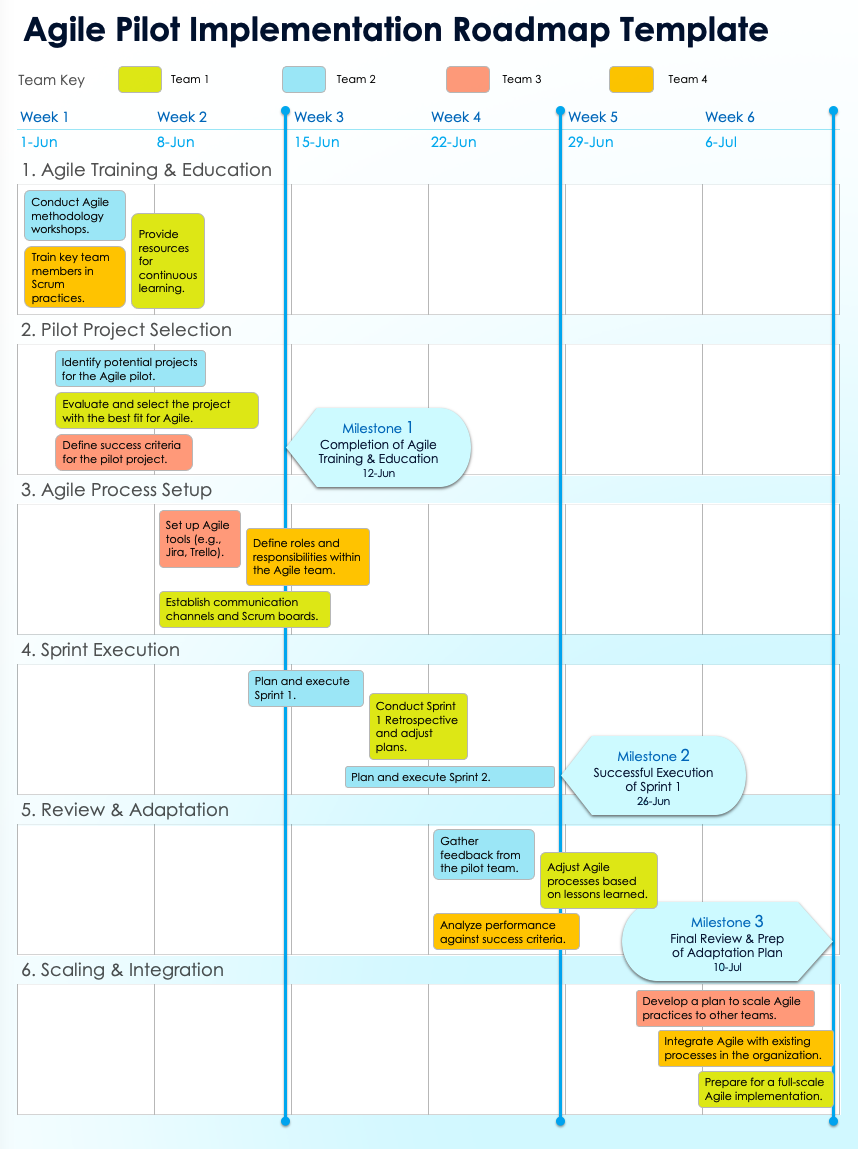
Download an Agile Pilot Implementation Roadmap Template for
Excel
|
PowerPoint
| Google Slides
Use this Agile pilot project implementation template to plan your initial project.
SAFe Agile Transformation Roadmap
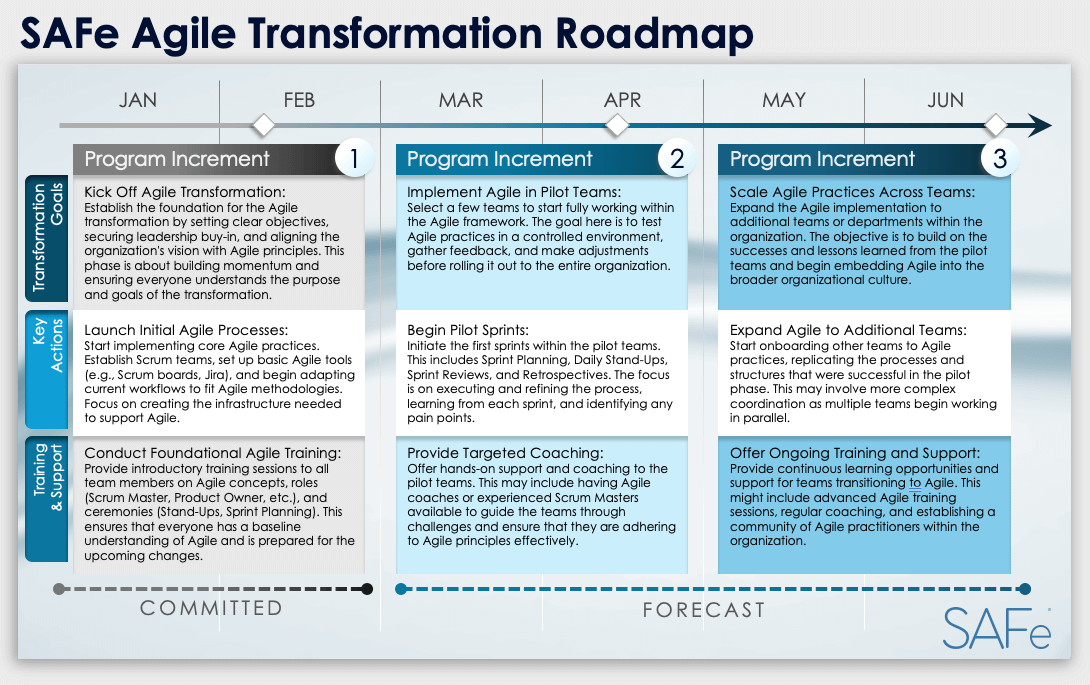
Download a SAFe Agile Transformation Roadmap Template for
PowerPoint
| Google Slides
Use this SAFe (Scaled Agile Framework) roadmap to scale your transformation projects throughout your organization.
Get started with a series of projects using this complete guide to Agile program management.
Agile Transformation Roadmap Starter Kit
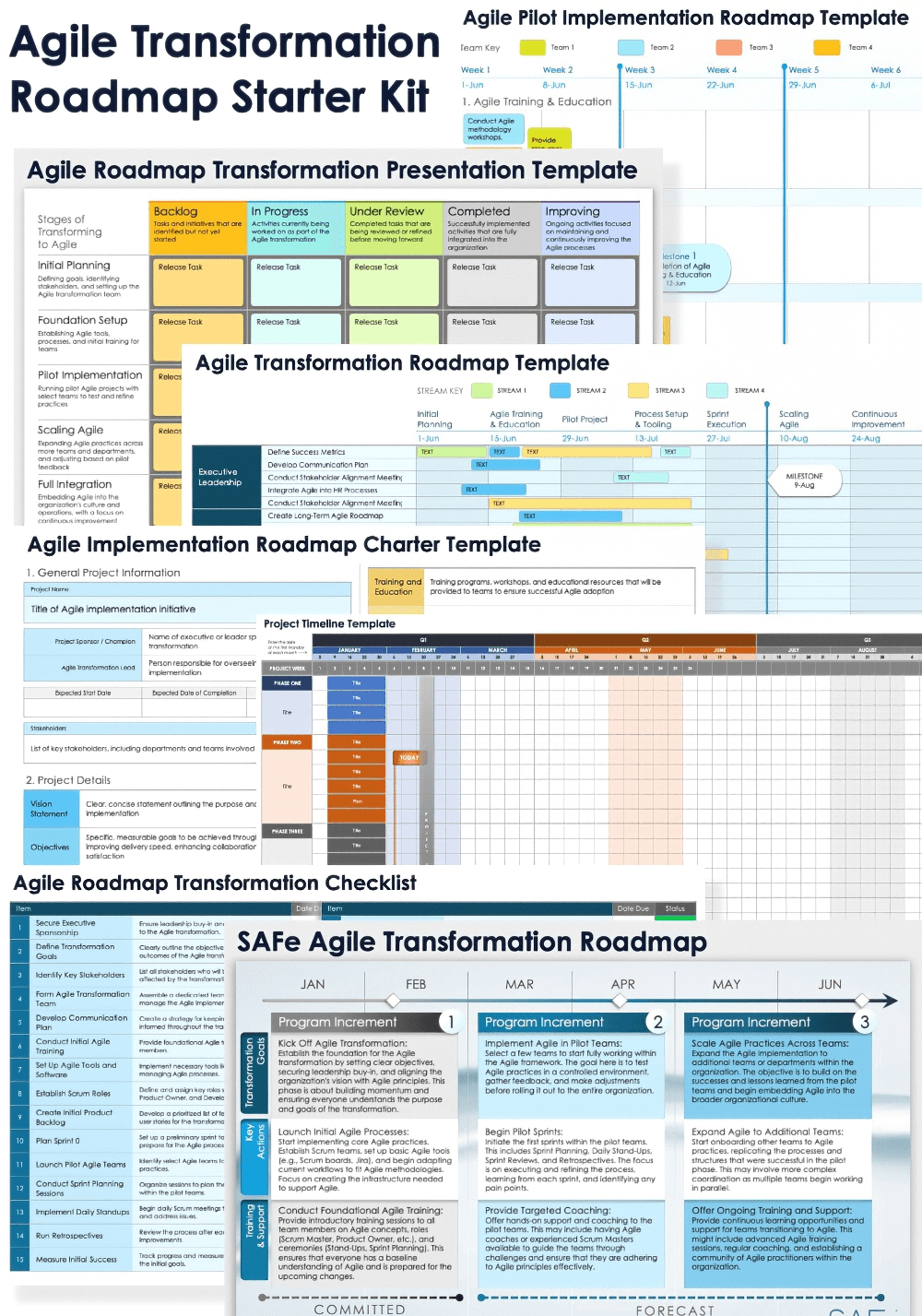
Download the Agile Transformation Roadmap Starter Kit
Use this free starter kit to plan and implement an Agile transformation. It includes templates for your overall transformation and for planning and tracking various parts of your Agile journey.
In this kit, you’ll find:
- A basic Agile transformation roadmap template in Excel and PowerPoint to plan your implementation holistically.
- An Agile implementation roadmap charter template in Excel and Microsoft Word to define other projects within the overall transformation.
- An Agile pilot project implementation template in Excel and PowerPoint to plan your initial project.
- An Agile project timeline template in Excel and PowerPoint to plan and track those projects.
- A SAFe Agile transformation roadmap in PowerPoint to scale your transformation projects.
- An Agile roadmap transformation presentation template in Excel and PowerPoint to communicate and review the plan with stakeholders.
- An Agile transformation roadmap checklist template in Excel and PowerPoint to ensure you’ve covered all the bases.
Benefits of Using an Agile Transformation Roadmap
The most important benefits of Agile transformation roadmaps are stakeholder alignment and clear communication. Roadmaps provide structure, but since they’re Agile, they also provide flexibility. Other benefits include risk mitigation, resource optimization, and continuous improvement.
Here’s a more detailed list of the benefits of Agile transformation roadmaps:
- Adaptability: By incorporating feedback loops and continuous improvement mechanisms, roadmaps enable organizations to remain flexible and responsive, adjusting the transformation process as needed to address emerging challenges or opportunities.
- Clarity and Alignment: Agile transformation roadmaps provide a clear, strategic vision that aligns all teams and stakeholders with the transformation’s objectives, ensuring everyone understands their roles and the overall direction.
- Continuous Improvement: By establishing mechanisms for regular feedback from teams and stakeholders, roadmaps ensure that the transformation process is continuously refined, improving outcomes and fostering a culture of ongoing learning and development.
- Cultural Transformation: Beyond process changes, roadmaps support the cultural shift required for Agile success by embedding Agile values and principles into the organization’s DNA, encouraging a mindset of collaboration, transparency, and innovation. Agile differs in key ways from other project management methodologies. Check out this comparison between Agile, Scrum, Waterfall, and Kanban to learn more.
- Enhanced Communication: A well-structured roadmap acts as a communication tool, keeping all parties informed, engaged, and aligned throughout the transformation, reducing resistance, and fostering a culture of collaboration.
- Performance Measurement: Roadmaps help organizations establish key performance indicators (KPIs) and metrics to evaluate the effectiveness of the Agile transformation, enabling data-driven decision-making and continuous optimization.
- Resource Optimization: Roadmaps allow for better planning and allocation of resources, ensuring that teams have the necessary support, tools, and training to effectively adopt Agile practices without overwhelming them.
- Risk Mitigation: Roadmaps help identify potential risks early in the process, allowing organizations to proactively address challenges, reducing the likelihood of setbacks and ensuring a smoother transformation journey.
- Scalability: Roadmaps provide a clear strategy for scaling Agile practices across the organization, ensuring that the transformation is sustainable and can be effectively extended to all relevant areas.
- Structured Progress: Roadmaps outline specific steps, phases, and milestones, helping organizations systematically track progress, assess results, and make informed decisions throughout the transformation.
Real-Life Examples of Agile Roadmap Benefits
People who use Agile transformation roadmaps enjoy several benefits. They note the time and energy that large-scale change takes, but they also point to better efficiency and productivity once Agile takes root. Experts agreed that the roadmap kept them on track.

Anmolika Singh, Data Scientist at Stanley Black & Decker, worked on an Agile transformation project at her company. Her roadmap, she says, focused on “iterative development, frequent feedback loops, and cross-functional collaboration.
“In practice, it allowed my team to quickly adjust to changing project requirements and deliver data insights more efficiently,” she adds. “However, the transition required a shift in mindset, especially in balancing the need for thorough data analysis with the rapid iterations that Agile demands.”

Daniel Meursing, CEO of Premier Staff, a luxury event staffing agency, led an Agile transformation at his company.
“Our roadmap began with a clear vision: to become the most responsive and adaptive luxury event staffing agency in the industry. We set milestones that aligned with major events on our calendar. For instance, we aimed to have our first Agile team operational by the time we staffed Justin Bieber’s world tour kickoff party. This tangible goal energized our team and gave us a real-world testing ground for our new processes.”
Meursing notes that the roadmap was essential to these processes, maintaining focus during transition and enabling the team to measure progress concretely. “By the time we reached our milestone of fully Agile operations for the Emmy Awards, we had increased our staffing efficiency by 40 percent and reduced last-minute changes by 60 percent.”

Derrick Boddie, Founder of Mango Innovation, led his company through an Agile change. This process began with educating everyone on the benefits of Agile, and then scaling the change over 6–12 months. The roadmap focused on key priorities, such as reorganizing into cross-functional teams, implementing two-week sprints, and adopting new project management tools. “We reviewed and updated the roadmap regularly based on lessons learned,” Boddie says.
“The keys were keeping the roadmap simple, transparent, and flexible. We celebrated small wins to maintain momentum, like completing our first full sprint cycle. Stakeholders appreciated the clarity around direction and timelines. Teams could adapt as needed while still progressing steadily toward our goal.”
Boddie adds that for Mango Innovation, “Agile change has boosted productivity, quality and client satisfaction. Our ability to continuously refine the roadmap based on feedback from staff and clients was crucial to success.”
Optimize Your Transformation Process With Real-Time Work Management in Smartsheet
From simple task management and project planning to complex resource and portfolio management, Smartsheet helps you improve collaboration and increase work velocity -- empowering you to get more done.
The Smartsheet platform makes it easy to plan, capture, manage, and report on work from anywhere, helping your team be more effective and get more done. Report on key metrics and get real-time visibility into work as it happens with roll-up reports, dashboards, and automated workflows built to keep your team connected and informed.
When teams have clarity into the work getting done, there’s no telling how much more they can accomplish in the same amount of time. Try Smartsheet for free, today.
